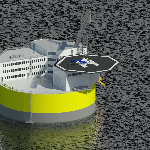
Offshore Floating Nuclear Plant: How to Enable a Large Nuclear Energy Expansion by MIT Floating Reactor
Please find below the
Finalist Evaluation
Judges'' ratings
| • | Novelty: | |
| • | Feasibility: | |
| • | Impact: | |
| • | Presentation: |
Judges'' comments
The contributor has proposed an Offshore Floating Nuclear Plant (OFNP) concept to utilize the vast amounts of ocean water for cooling in case of events and an in-building manufacturing process to maximize productivity. At a first glance, the proposed scheme adds significant cost to the structure vs on-shore nuclear power plant and positions the nuclear plant in an location more exposed to terrorist attacks. Furthermore, as mentioned by Tim, team's estimate for time to market appears to be unreasonably optimistic. However it may be worthwhile to further investigate the cost side, both in the manufacturing and in the construction/movement of the OFNP.
This is a very interesting high level concept. Many questions remain that must be answered before one can judge whether or not this could be viable. However, the team appears to have a good handle on many of these questions and describes a reasonable path forward. It would have been helpful to have more details at a back-of-the-envelope level to assess whether there is any chance that this could be cost effective.
While there are certainly a number of obvious safety questions that would need to be addressed, in my view, none of these are technically or economically insurmountable. Moreover, the concept also has many clear advantages over the traditional model of custom-built land-based 3,000 MW power plants. On balance, this concept may well prove to be both cheaper and safer.
The advantages of mass production, in particular, could make a relatively small power plant economical to build and operate. Designing safety systems for a relatively small power plants, e.g., 100 MWe, is considerably simpler than for larger units. For example, it may be possible to design an entirely passive mechanism to maintain the core safely cooled in the event of an accident for these types of reactors. For land based pressurized or boiling water reactors, the type in use in the US, this is not possible. That is, the safety systems have to be powered to “actively” circulate the coolant through the reactor.
Also, a floating nuclear power plant is not an entirely new concept. The US and British navy have more than half a century of experience operating nuclear powered vessels. The proposed commercial reactor described here, in many respects, would be simpler and easier to design for they would not need to meet specifications for military propulsion (e.g., rapid power up and acceleration).
Semi-Finalist Evaluation
Judges'' ratings
| • | Novelty: | |
| • | Feasibility: | |
| • | Impact: | |
| • | Presentation: |
Judges'' comments
Hello, Congrats.
Please see the comment section to see the Judges' direct feedback. Areas to consider are cost effectiveness, a SWOT analysis (Strengths, Weaknesses, Opportunities and Threats), and some specificity to an actual location/ project.
We look forward to your updated proposal!
No comments have been posted.